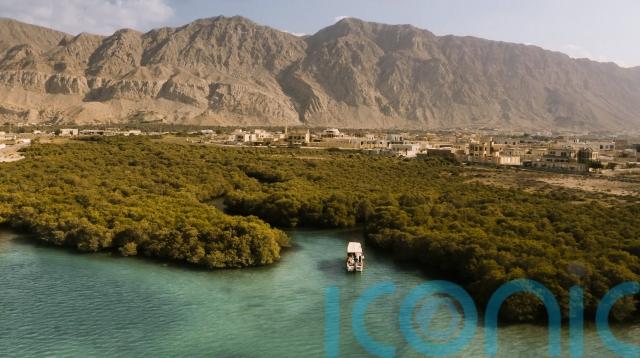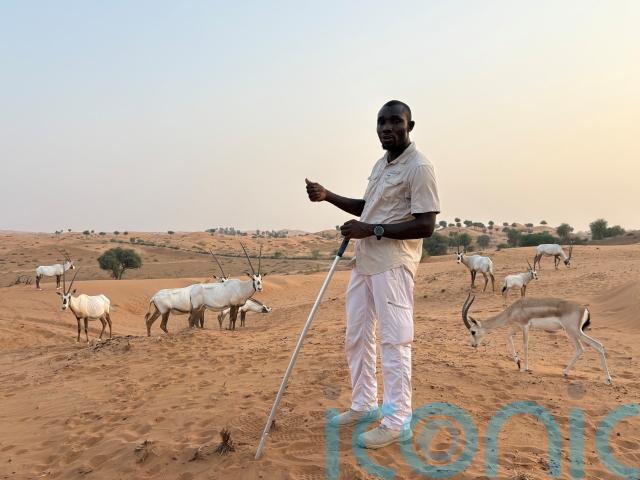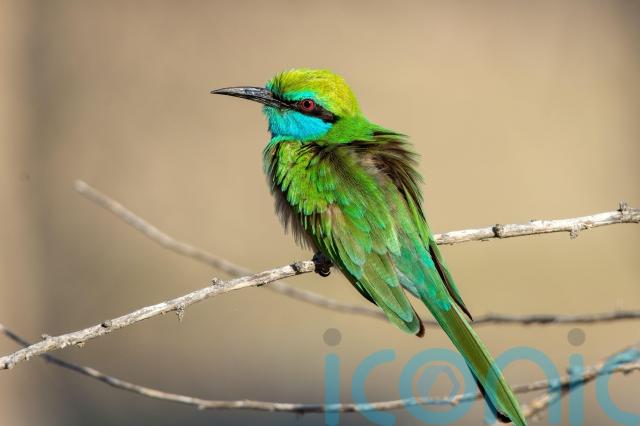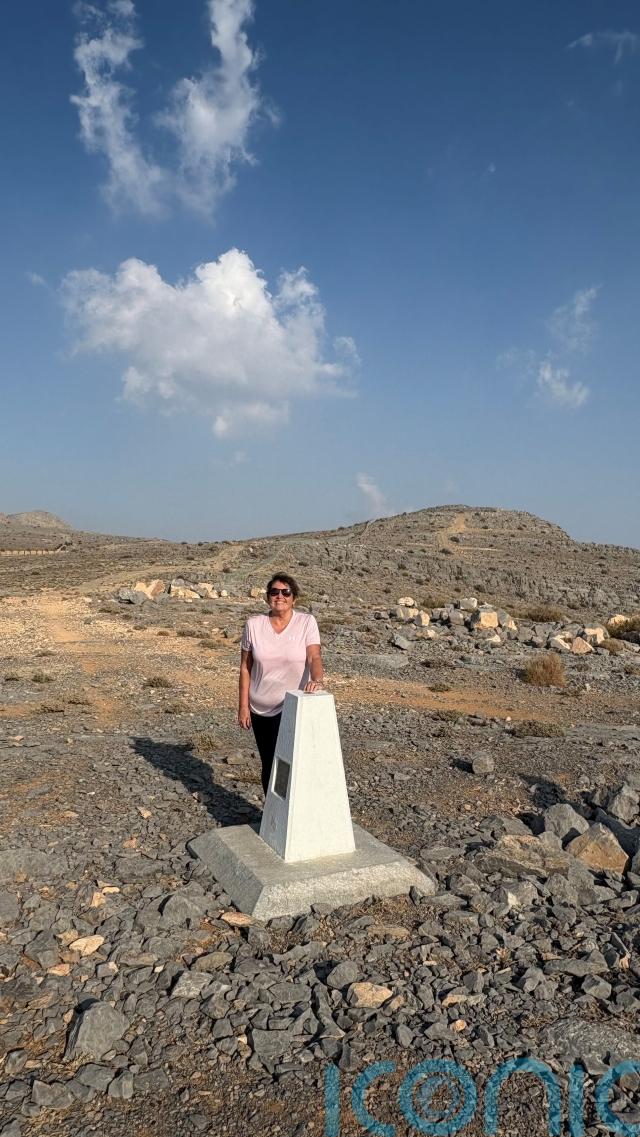
In the middle of the Al Wadi desert, an elegant white Arabian oryx, the national animal of the UAE, approaches our group, its ringed pointed horns almost as tall as the beast itself.
Standing close enough for me to take a good picture, it doesn’t seem a threatening situation, as smaller sand gazelles skitter among the larger antelopes and happily approach tourists to be hand-fed veggie pellets.
But then our guide Ernest Opare shows the holes which have pierced the metal in the wing of his wadi-bashing 4×4 vehicle, the result of an attack by an aggressive oryx who thought her calf was under threat and charged the vehicle, forcing him to take evasive action.
“If they come very close you have to stand still and if they are going to attack they will give a warning sign, a loud bleating,” he explains warily.
We are in the little known emirate of Ras Al Khaimah, the fourth largest and most northerly of the UAE’s seven territories, often abbreviated to RAK and known as the ‘nature emirate’ due to its varying terrain of mountains, mangroves, sea and desert.

An hour’s drive north from Dubai and bordering Oman, RAK already has a string of glitzy hotels along its coast and more in the making, plus a casino scheduled to open in 2027, ideal for those who just want to fly and flop on a winter sun break.
You can get hugely sophisticated fine-dining experiences, hair-raising flights over the gulf and heart-stopping adventure pursuits, yet there is a more laid-back feel to this emirate than its famous neighbour and certainly less traffic. RAK welcomed 1.28 million tourists in 2024 compared with Dubai’s 18.72 million.
In Dubai it may take a good half an hour just to get off its manmade archipelago The Palm. In RAK, you can be in a nature reserve in the same time or breathing the cooler air of the Hajar Mountains in an hour.
Ernest is a nature guide at the five-star Ritz-Carlton Al Wadi, set in a patch of Arabian desert within the Al Wadi Nature Reserve spanning 1,235 acres, with its sumptuous tented villas and sandstone-coloured low-rise accommodations.

The Arabian oryx (also known as the white oryx) was declared extinct in the wild in 1972, because of unregulated hunting, killed by Bedouin for its meat and hide, and by trophy hunters. The few that were left remained in zoos and private parks.
But a conservation project has resulted in it becoming the world’s first species to be successfully reintroduced into its natural habitat. In 2011, Al Wadi welcomed nine oryx and now there are well over 100 within the reserve, Ernest says proudly.
Our genial guide also conducts night tours with torchlights – when visitors are urged to wear long trousers, sturdy walking shoes and socks – in search of nocturnal wildlife, including the venomous – but shy – Arabian horned viper, scorpions, lizards, spiders, hedgehogs and gerbils.

During the day, he points out burrows in the sand, created by Arabian red foxes and eagle owls, and talks of the stunning birds including the Indian roller, with striking blue markings on its wings, colourful bee-eaters and kestrels.
When the heat of the desert becomes too much – which is throughout the summer months – RAK has other nature and adrenaline-rush opportunities in the mountains, most notably at Jebel Jais, the highest point in the UAE at 6,345ft (1,934m) and part of the Hajar (which means rocky) Mountains.
Jebel Jais has been an adventure playground for a while. Thrill seekers can whoosh over the mountains on Jais Flight, the longest zipline in the world, stretching 2.83km at a height of 1,680m above sea level across dramatic canyons, reaching speeds of up to 99mph.

It’s not as scary as it sounds once you’re trussed up like a chicken in a stretcher-like harness, face-forward, but it is exhilarating to experience the speed and the mountains.
Other adventure attractions include Via Ferrata, heart-pounding guided climbs with the help of fixed steel cables and safety harnesses, and survival skills at Bear Grylls Explorers Camp down the road – although word has it the man has never been there himself – where ex-military instructors offer everything from gentle hikes to tough overnighters in this unforgiving terrain.
A few cabins at base camp provide basic accommodation and there’s archery and air rifle ranges to hone your skills.
But we head for Camp 1770, the highest campsite in the UAE at 1,770m above sea level (hence the camp’s name), run by Fadi Hachicho, owner of Adventurati Outdoor.
Being here makes you quietly contemplate how small you are in the much bigger picture of the universe. In the last four years 94km of trail has been built by hand, not using machinery – and it’s still expanding.
“People can come in and design their own hiking trails from this network, which covers different elevations and difficulties,” says Lebanon-born Fadi, who moved from Dubai to RAK because of the natural outdoor opportunities it offered.
The camp, which could be a million miles away from the hotel-filled coast, is all earthy colours accented with bright Middle Eastern rugs and cushions in shades of red and cream, the Hajar Mountains filling every viewpoint.
It’s also one of the few places you can escape the intense heat, being around 15 degrees cooler than the city.
“It’s a place to slow down and connect with nature,” says Fadi. “Its beauty is in its simplicity, designed for adventure lovers and nature lovers, where your mind is out of office.”
He leads us along the rock-strewn path to a white marker where you can have one foot in RAK and the other in Oman. Camping in tents, cooking together and facing challenging terrain can all be part of the experience.
You may see goats and mountain hamsters, but you’re unlikely to catch a glimpse of mountain lions or Arabian tigers, he chuckles. During the cooler months, valleys blossom with wildflowers.

Sound healing sessions, where you can contemplate and meditate, are available, and it’s the only place in the UAE where you can see the sun rise over the Indian Ocean and set over the Arabian Sea, he tells us over traditional Arabian fare including sweet noodles, luqaimat (date syrup-covered donuts) and Emirati pumpkin pudding, made by local mountain-dwelling tribes.
Despite the extensive continuing development along the coast, some efforts have been made to retain the natural mangroves, home to green turtles, flamingos and manatees.
The five-star Anantara resort, for instance, was built around the mangroves, which you can admire from the bridges leading to the overwater villas or from kayaks for a closer view.
Some heritage has remained, we discover, catching a boat at the Suwaidi Pearl Farm, the region’s first cultured pearl farm and the only surviving one in the Gulf, passing swathes of mangrove flanked by the mountains on one side and camels taking a swim on the other.
Set up in 2004 by the grandson of a local pearl-diver, our guide Obain explains the rich history of Arabian pearl diving, how a pearl is formed and the hardships the divers went through to extract these valuable commodities.
This lesser-known emirate offers a mixture of old and new – the extravagant hotels, the traditional industries, the adrenaline fixes. But for me, hopefully the mountains, the desert – and the oryx – will prevail in this sea of change.
How to book:
Prices at Anantara Mina Ras Al Khaimah Resort start from £226.35 per room, per night, on a B&B basis, based on two people sharing in January 2026.
Al Rimal villas at the Ritz-Carlton Ras Al Khaimah, Al Wadi Desert start from £515 per room, per night, on a B&B basis, based on two people sharing in January 2026.
For more information go to visitrasalkhaimah.com
Subscribe or register today to discover more from DonegalLive.ie
Buy the e-paper of the Donegal Democrat, Donegal People's Press, Donegal Post and Inish Times here for instant access to Donegal's premier news titles.
Keep up with the latest news from Donegal with our daily newsletter featuring the most important stories of the day delivered to your inbox every evening at 5pm.